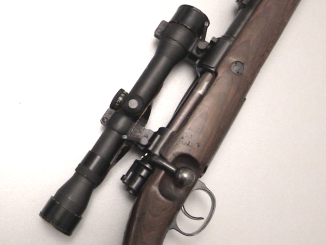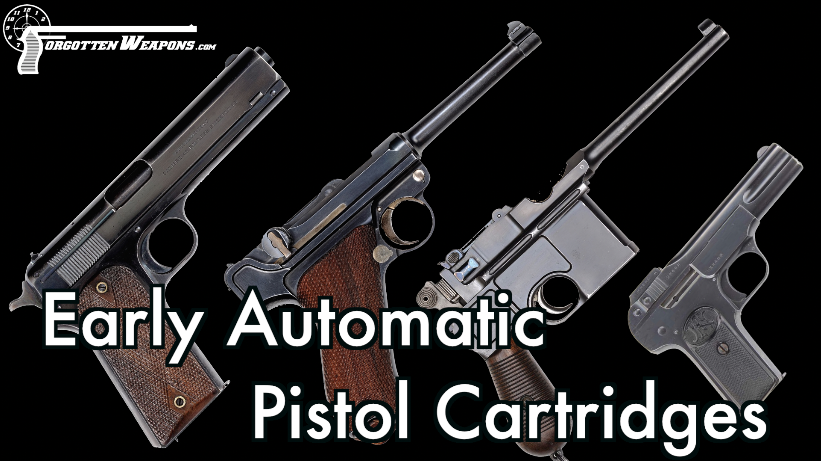Georg Roth’s company in Austria presided over a wonderful variety of interesting handgun development, and this is one example of that lineage. Roth’s licensed or purchased the patent for this pistol from its inventor, Wasa Theodorovic, and turned it over to his engineer Karel Krnka to develop (I’m simplifying this). The design used a long recoil action and a rotating bolt, elements which would later find their way into the designs of Rudolf Frommer, who worked at FEG where the Roth pistols were manufactured.
About 80 of these Roth-Theodorovic-Krnka pistols were made, with no two quite the same. They were in a constant process of development and improvement, and this (serial number 77) is one of the very last ones. It exhibits a quite refined fire control system with single and double action modes as well as a decocker. It is made yet more interesting by the addition of a grip safety, which does not appear to be a factory element. Instead, it appears to be a design patented by Tambour and installed by a contemporary gunsmith. Tambour safeties were put in a number of other types of guns at the time, including Mannlicher 1901/1905 pistols.




Grip safety additions onto an inherently safe product imply that someone has a problem with drawing from a holster. I don’t think that anyone would carry this in the “ready to shoot” condition with a round in the chamber… or am I wrong?
This one is awesome. I love these early autos. Thank you for posting.
Is that flag (red stripe – white stripe – red stripe) proper?
I would expect either black-yellow flag (Habsburg flag) or that Austrian and Hungarian colors, as seen here:
https://commons.wikimedia.org/wiki/File:Flag_of_Austria-Hungary_(1869-1918).svg
(which would made big sense considered that FEG were in Hungarian part)
(Something wrong happen to link, copy whole line and paste into address bar and it will work)
It seems that Krnka stick to rule: use small number of parts, but at a cost of its sophisticated shape. I am wondering how many man-hours were needed to craft one example?
A great many hours were spent on machining the parts. If Krnka had stuck to parts that were easily crafted, how would they work? And how many simple parts would be required to replace the complex units? Or had precision cast parts existed, would they be cheaper than machined parts? Let’s just use castings wherever machined complex shapes wouldn’t be practical…
IIRC Repetierpistole M.7 was sell to Austria-Hungary with one-unit price lower that cost of production.
There was also Krnka 1899 self-loading sporting/hunting rifle, IIRC its price in United States in 1900s was $150 (notice that there are 1900s $ not 2000s $), which is big even considered needed of shipping over Atlantic.
Has anyone price of Roth-Sauer 1900 automatic pistol? And possibly some one German or Austrian guns for comparison?
I design gun parts for a living and that trigger mechanism made me go “WOW!” when I saw how complex yet refined and elegant it is.
Tip of the sake cup to the firearm designers in the old Austro-Hungarian Empire. They came up with some epic/intricate designs. I want one of each.
Ian,
Thanks so much for showing these fantastic early self-loading designs. Workmanship, mechanical innovation, and a great window into the many options that were being investigated at the time. No CAD available in these days folks, if you wanted to know, you had to cut metal! ^__^
Little info on Teodorovic:
Vasilije “Vasa” Teodorovic, ethnic Serbian, his father Milan Teodorovic was employee of the Gasser factory.
Vasa Teodorovic worked for Roth and Steyr. Died 1927 or 1929.
There was another Teodorovic who worked for Steyr who is noted in Serbian contract for Model 1910 Mauser rifles, but his name is different (A. Teodorovic), so not the same person, but possibly a relative.
Bojan,
Thanks for new info. When was Milan Teodorovic employed by Gasser and in what position? I’m interested in Gasser history. Thanks.
What a beatifull piece. A mechanical lace of finely made parts. This pistol should also be designed for cavalry use. Trigger pull long enough not to be activated through accidental, unwanted trigger finger movements. Loading through clip feed needs a special care and application not to chamber a round and this kind of pistols usually carried with a live cartridge in the barrel and need impact elements taken off from the case cap, that is being in the half cocked mode.
Therefore, backward movement of breechbolt in this gun takes the action into the partly cocked form and firing needs additional compression of hammer to enable to get the sufficient impact for discharging. Reciprocal moving level of breechbolt underside can not force the hammer onto the full cocked form, but the user can manually take it there if requires more precisly aimed shots. In case of giving up, decocker lever is ready to carry the hammer into the half cocked mode. Since the trigger action can both cocks and releases the hammer, therefore performing the two needed actions for the DA lockwork, it should not be considered as the true DA by the cause of the nonability of second strike capability. IMHO.
Mechanical excellence here wasn’t carried to the next generation, and that sucked for Austrians. After 1918, it appears that the prominent gun making talent of the former Habsburg Empire went to Czechoslovakia if my studies are right.
“After 1918, it appears that the prominent gun making talent of the former Habsburg Empire went to Czechoslovakia if my studies are right.”
After 1918 there were some good quality fire-arms in Austria, for example:
ÖWA automatic pistol firing 6.35mm cartridge (.25 Auto)
MP34 made by Waffenfabrik Steyr
Also notice that after 1918 Austria-Hungary’s territory was dived between several countries. You should check fire-arms manufacturer of that countries and is links (of lack of links) to Austria-Hungary.
IMHO another candidate for modern reproduction like so many others. Of course if somebody did it would probably be 1500 USD each.
Not a chance. It’s a pistol with no following, hence no market, and if you really, really want one you can find them at a affordable price for that same reason. I want one too, only I don’t really, really want one because I have other “targets” that I want more. I have a friend that just bough a Roth, but it was behind a hundred other handguns he purchased before that. What I am puzzled about is why no one has made a reproduction civil war Kerr revolver…now that one has a potential market that would keep the price down.
“What I am puzzled about is why no one has made a reproduction …”
Considering the sky-high market prices of many of these antiques, I’ve often wondered how many one-off reproductions could have been passed off as originals of some kind.
For regular gun manufacturing, I wonder what size of production run is roughly needed to keep the unit price down to an affordable level? A graph of some kind regarding unit cost vs. production volume would be interesting to see.
I look forward to the day, hopefully not too far distant, when *metal* 3D printers will be cheap enough and good enough for people to simply “print” their own guns, ideally all the way down to the smallest screws and springs
“For regular gun manufacturing, I wonder what size of production run is roughly needed to keep the unit price down to an affordable level?”
Answer for this question would be complicated if not impossible.
You have to:
-define what affordable mean
-check any payment necessary to make weapon production legal (license for production, patents and other)
And anyway all would depended on weapon design or rather manufacturing technology and possibility/impossibility of usage of existing machines.
“*metal* 3D printers”
Interesting, as it would create new different technology and thus new design-constraint and possibilities, unlike used and known technologies as machining, stamping or casting (used to produce Whitney Wolverine .22 rim-fire automatic pistol)
@aa:
For automatic pistol based on Repetierpistole M.7 see Musgrave (1991):
http://raigap.livejournal.com/494090.html#cutid1
Make it as a BB/CO2 gun
I”m still waiting for a welrod in BB
Okay, so I can assume you’d have the barrel fixed or bolted to the frame and have most of the locking pieces removed. The charging handle would still be needed to get a good amount of gas behind the pellet. The removable side plate and grip panel would allow you to easily change gas cylinders, but how do you want to load the pellets into the magazine? Strip chargers aren’t really practical unless you want BB guns with reusable pellet cartridge casings that would function like the original cartridges; just hold the ammo until the gas shoves it out the muzzle.
Did I mess up?
Good question the best bet would be the self contained brocock air cartriges With the luger webley mauser 96 nagant and now the SW schofiels it shows that there is a lot of interest out there from people like me that due to financial or legal reasons cant own the real thing